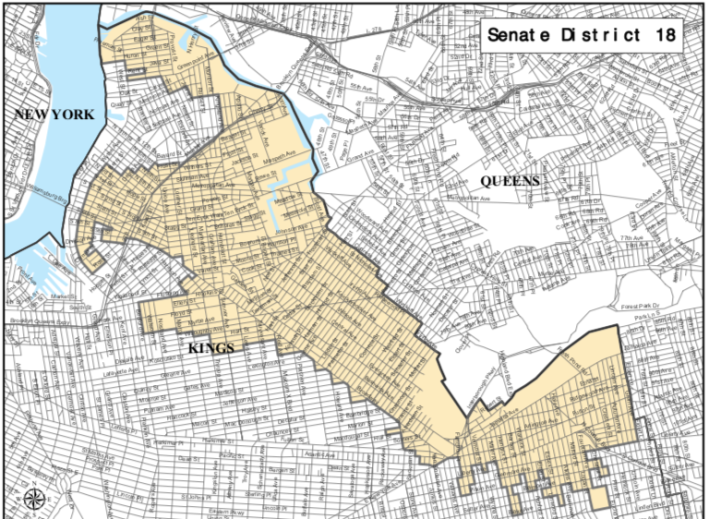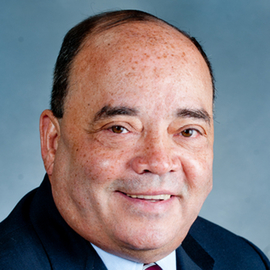Insurgent candidates are challenging incumbents in Albany this year like never before — and for good reason: The State Senate's failure to pass speed camera legislation this summer, the legislature's stall on congestion pricing, and the upper chamber's general political dysfunction are motivating people to focus on whether Albany itself is working.
So Streetsblog asked candidates in the upcoming Democratic primaries to answer basic questions about street safety and mobility. Today we look at Brooklyn's 18th Senate District, pitting challenger Julia Salazar vs. incumbent Martin Dilan. StreetsPAC endorsed Salazar (perhaps because she's come out in favor of the "Idaho stop," as you'll see below). It's a key district that will be greatly disrupted by next year's L-train shutdown, so Streetsblog threw in an extra question in this particular race.
Here are the candidates' answers, unedited, with a map of the district at the bottom of this post:
Do you support congestion pricing in New York City? If so, in what form? If not, why not?
SALAZAR: I do support congestion pricing in NYC, and recognize it as both a crucial way to address spiraling levels of traffic congestion and a progressive way to fund transit improvements. I would support a congestion pricing plan similar to one put forth by the MoveNY coalition, which creates a consistent toll cordon within Manhattan’s CBD, provides some toll relief to outer borough drivers, and targets transit improvements into neighborhoods that would get more New Yorkers out of their cars and onto public transit. I also support a millionaire’s tax to fund the MTA, and I reject the argument driven by the Mayor and the Governor’s feuds that suggests that these are opposing positions.
DILAN: I do support congestion pricing. What iteration will pass the Legislature, I am still uncertain. However, I am not adverse to a hybrid package with a new, dedicated revenue source outside of congestion pricing to aid in funding the MTA’s critical maintenance, upgrades and expansion.
Additionally, with congestion pricing and new revenue streams, riders/taxpayers deserve to know the goals of expansion and we must hold the MTA accountable. This is important for system wide ridership but especially for areas that are currently underserved.
Subway ridership is down and New York's buses are slower than ever. What will you do in Albany/are doing in Albany to fix it?
SALAZAR: We must open up steady, debt-free funding streams to the MTA, through congestion pricing and a millionaire’s tax as mentioned above. Sound paths forward for the subway and bus system have been outlined by the new MTA President Byford in his Action Plans, but funding details were deliberately withheld thanks to Cuomo and Senate Republicans’ deprioritization of the MTA. In the State Senate I will fight to fully fund our transit system and modernize our aging subway infrastructure immediately.
I support the TransitCenter’s Bus Turnaround plan, and in Albany would advocate that its recommendations be fully implemented. Some of them, including bus network redesign and new fare technology, appear to be imminently in the works at MTA — as State Senator I would work to make sure that they are substantive improvements and put riders first.
I would also support the expansion of bus lane cameras to automate enforcement of bus lane violations, to both remove police encounters from this kind of enforcement and to ensure that it actually happens (as NYPD does not prioritize this and often blocks the lanes themselves).
DILAN: I sponsor legislation with Senator Krueger that would allow for bus lane and light enforcement cameras throughout the city. The measure would also establish a schedule of fines that would be directed to the New York City Transportation City Assistance Fund. This would allow for increased funding and improve bus expediency.
Additionally, I have sponsored legislation that would have directed a percentage of the collected sales tax from TNC rides to transportation assistance funds in the MTA region and state wide. With partial congestion pricing enacted during the previous session, I will have to revisit this legislation. However, it’s intent is to drive funding to a system in need of emergency action.
MTA capital projects routinely cost five times as much as transit projects in other cities. How will you exert pressure on the MTA to control costs?
SALAZAR: We can control MTA construction costs by tackling the roots of mismanagement and corruption and not demonizing workers who have fought for and earned good wages and protections. We must look to European cities that have been able to maintain and expand their transit systems more cheaply, more quickly, and with similar or better worker protections. Real competition must exist between contractors, and the state must do all it can to support competition and to expand the market of contractors that do this work. We must limit the use of costly consultants and encourage as much work as possible be done in-house at MTA. Efficient staffing reforms negotiated in concert with unions can be achieved without threatening protections and wages. As State Senator I would support legislation that reforms contracting rules and call for consistent oversight hearings regarding the MTA Capital Plan — a practice barely pursued by the current State Senate — to keep the authority accountable and transparent.
DILAN: It is beyond important to hold the MTA accountable. It is hard to accept the argument that NYC is so unique that construction projects must cost multiples to that of other big cities projects. As such, I will seek hearings beyond our annual budget hearing in March to ask difficult questions, and bring in experts to gain different perspectives.
How would you make streets in your district safer for walking and biking? Do you support the city's construction of protected bike lanes? If so, why? If not, why not?
SALAZAR: I support the DOT’s implementation of pedestrian safety projects and protected bike lanes and as State Senator, I would offer my access to community institutions to help DOT conduct outreach that helps residents feel heard in these processes. I would also use my office to solicit safety concerns from constituents and frequently issue requests to the agency to address dangerous locations in my district. I recognize that my position as an elected official would have a significant influence on NYCDOT’s internal prioritization of safety projects, and I intend to use it to support their vital work in my district. DOT’s record over the past decade in driving down traffic fatalities against national trends is one of the great recent achievements of our city’s government, but we have a way to go before reaching Vision Zero. I reject arguments that halt or kill projects that are proven to save lives in order to save a handful of parking spots. I support protected bike lanes as one of the many transformative tools within the DOT’s safety toolkit because they’re not only proven to improve bike safety and encourage increased cycling, but they also improve pedestrian and motor vehicle occupant safety where they are implemented.
DILAN: I sponsored Complete Streets legislation nearly a decade ago that would mandate considerations of all users in construction projects. I supported lowering the speed limit in NYC and do support protected bike lanes. I believe NYC has the potential of becoming the example for other big cities. It is not an easy thing to accomplish and success will likely be found in a generational timetable, however, I am happy to be a part of promoting this focus.
What is the single biggest thing the state should do to get reckless drivers off New York City streets?
SALAZAR: The DMV should standardize a penalty system for reckless driving that can lead to license suspensions, and increase penalties for behavior that results in injury or death. We can create a system that properly acknowledges the societal dangers of driving and prevents reckless drivers from getting behind the wheel by encouraging better driving through license penalties first — not through criminalization.
DILAN: We all know that street design has been shown to slow drivers, and improve safety for pedestrians and cyclists. However, design elements alone cannot rid streets of reckless drivers. Legislating behavior is always a challenge, but legislation with enforcement that is tied to public awareness campaigns have proven successful. Seatbelt usage is a great example of the possibilities.
We must remember that driving is a privilege, not a right. Habitually reckless drivers should not be allowed to continue to put others at risk. I believe we must look at expanding license revocation for persistent offenders while continuing to educate drivers, especially new drivers, to the dangers of reckless habits. I feel we are doing a good job with cell phones and texting while driving state wide and the Mayor’s office has focused on educating the city on Vision Zero policies.
Is there a safety, design or enforcement strategy that is not being deployed that you think is vital to making our roadways, sidewalks and public spaces work better for everyone? (Hint: This is a "visionary" question, so don't think small.)
SALAZAR: The speed camera program should not only be renewed but expanded significantly beyond a small number of schools in the city, and should not only be placed in front of schools, as they are proven to drive down speeding and take police bias and encounters out of the enforcement equation. I strongly support current efforts to regulate the private hauling industry, which has a number of labor and environmental benefits but is also a disproportionate cause of traffic violence in the city. My district has one of the highest rates of cycling in the city, and we need creative expansions of safe bike parking in the district. I also support the “Idaho Stop,” that would allow cyclists to legally treat stop signs as yield signs.
DILAN: Absolutely: make Manhattan car free. If there were no cars, and everyone lived within a few blocks of truly accessible and reliable transit, the city would be a much safer place.
Here's a district-specific question: What is missing in the current MTA and DOT plan for mitigating the inconvenience and traffic of the impending 15-month L-train shutdown?
SALAZAR: I believe the plan should include 24 hour bus lanes. I also am skeptical that HOV-3 will be enough to keep the Williamsburg bridge clear enough to process buses at the rate needed, and would support making the bridge bus-only during the shut down. I am deeply concerned about the burden placed on the already overcrowded A/C and J/M/Z lines within my district and do not believe MTA has invested enough in expanding capacity on these lines.
DILAN: The Canarsie Tube repair is no laughing matter. I think the MTA and DOT have done a fair job of outreach to the community and are working diligently to come up with a plan to mitigate the impact. However, I do not believe we are prepared for what is to come. A shutdown to this degree is unprecedented.
Unfortunately, I fear we will learn a lot during and from the 15 months following March of 2019. I believe “dry runs” of the mitigation strategies must be enacted weeks before the tube closure and all options must be on the table. Dedicated bus lanes on the Williamsburg Bridge, with electric buses, are critical. We must also monitor those trying to take advantage of riders impacted by the shutdown with the creation of “shuttle services”. From a consumer protection aspect and also for a congestion concern.
How often do you bike to the office (be honest)?
SALAZAR: Almost never — it’s been too hot this summer! But I fully support making streets safe for bikers.
DILAN: I do not bike to the office. However, I am part of a group that cycles daily for exercise and pleasure in Cypress Hills. Unfortunately, my schedule doesn’t allow me to get out there everyday. Also, with the increased acceptance of electric assisted bicycles, a means of transportation that I think is a no brainer for multiple reasons and have sponsored for years, it may be possible for me to bike more throughout the community.









